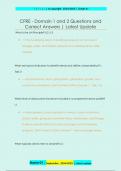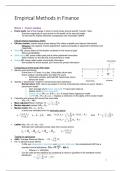1 | P a g e | © copyright 2024/2025 | Grade A+
CFRE - Domain 1 and 2 Questions and
Correct Answers | Latest Update
What is the LAI Principle? II.2, II.3,
✓ ~~>The fundraising axiom of qualifying prospects on the basis of
Linkages, Ability, and Interest. (Glossary of Fundraising Terms, CFRE
website)
What are typical indicators to identify trends and define characteristics? I,
Task 3
✓ ~~>Socioeconomic status, giving history, generation, gender, and
culture of a constituency (Test Content Outline: Domain 1 - Task 1.3)
What kinds of data points should be included in a prospective donor profile?
I.1
✓ ~~>Demographics, psycho-graphics, interests, values, motivations,
culture, ability, giving and volunteer history, relationships, and linkages
to select potential donors for particular projects and fundraising
programs. (Test Content Outline: Domain 1 - Key Knowledge Areas)
What typically drives men to donate? II.2
Master01 | September, 2024/2025 | Latest update
, 2 | P a g e | © copyright 2024/2025 | Grade A+
✓ ~~>Traditional strategies, such as campaigns, peer
recognition, sense of urgency, deadlines, competitive, fast-paced, intense
efforts. (AEF, p117)
What typically drives women to donate? II.2
✓ ~~>An organization's engagement, relationship
building, thank you notes, mission connection, impact stories, regular
stewardship, female leadership, diversity, and are often the philanthropic
decision makers in their homes. (AEF, p119)
Who are more likely to donate: women or men? II.2
✓ ~~>According to the Women's Philanthropy Institute's "Women Give"
series, women are often more likely to make donations as similarly-
situated men. (AEF, p115) In 2 studies of high net worth households, 9
out of 10 women are either the sole decision maker or at least an equal
partner in charitable decision making. (AEF, p116)
What are Cohort and Lifecycle effects in relation to generational giving? II.2
Master01 | September, 2024/2025 | Latest update
, 3 | P a g e | © copyright 2024/2025 | Grade A+
✓ ~~>A cohort effect is characteristic of people in the group
*throughout* their lives. An example would be the lifelong impact of
economic scarcity from the Great Depression on a generation's
attitudes towards money and philanthropy. A lifecycle effect changes
as an individual grows older. An example might be a young person
who becomes more generous in their 40s because she has more
disposal income than she did in her 20s. (AEF, p171)
What are the top 5 charitable causes that individuals are likely to support,
across all generations? II.2
✓ ~~>Local social service, place of worship, health charities, children's
charities, and education. The first four causes remain prominent across
different generations, but there is variance across the fifth selected
cause, depending on the generation. (AEF, p173).
What are the elements of an effective case for support? II.1, 11.3, II.4
✓ ~~>Mission Statement, Goals, Objectives, Programs & Services,
Finances, Governance, Staffing, Service Delivery, Planning &
Evaluation, History (AEF, p40-41)
How do Goals differ from Objectives? II.1, 11.3, II.4
Master01 | September, 2024/2025 | Latest update





